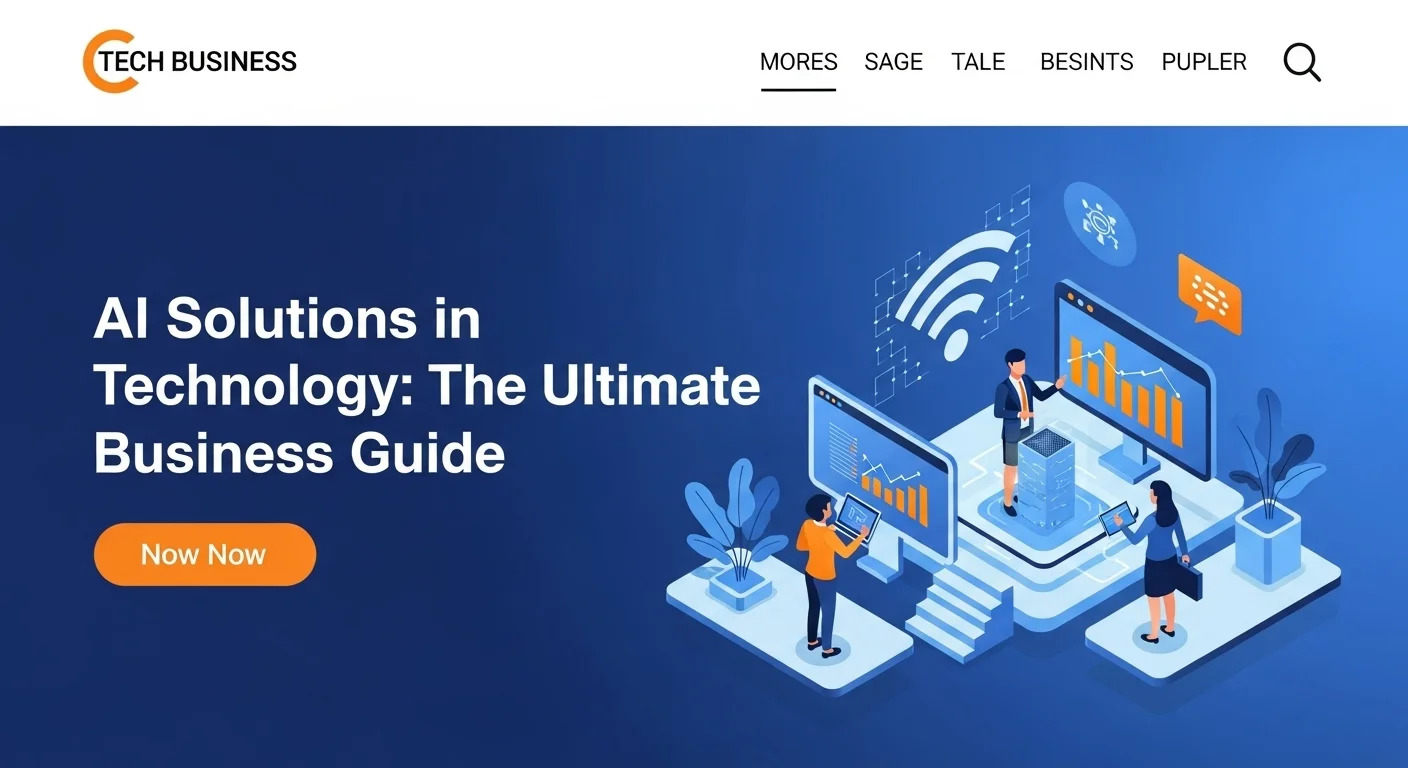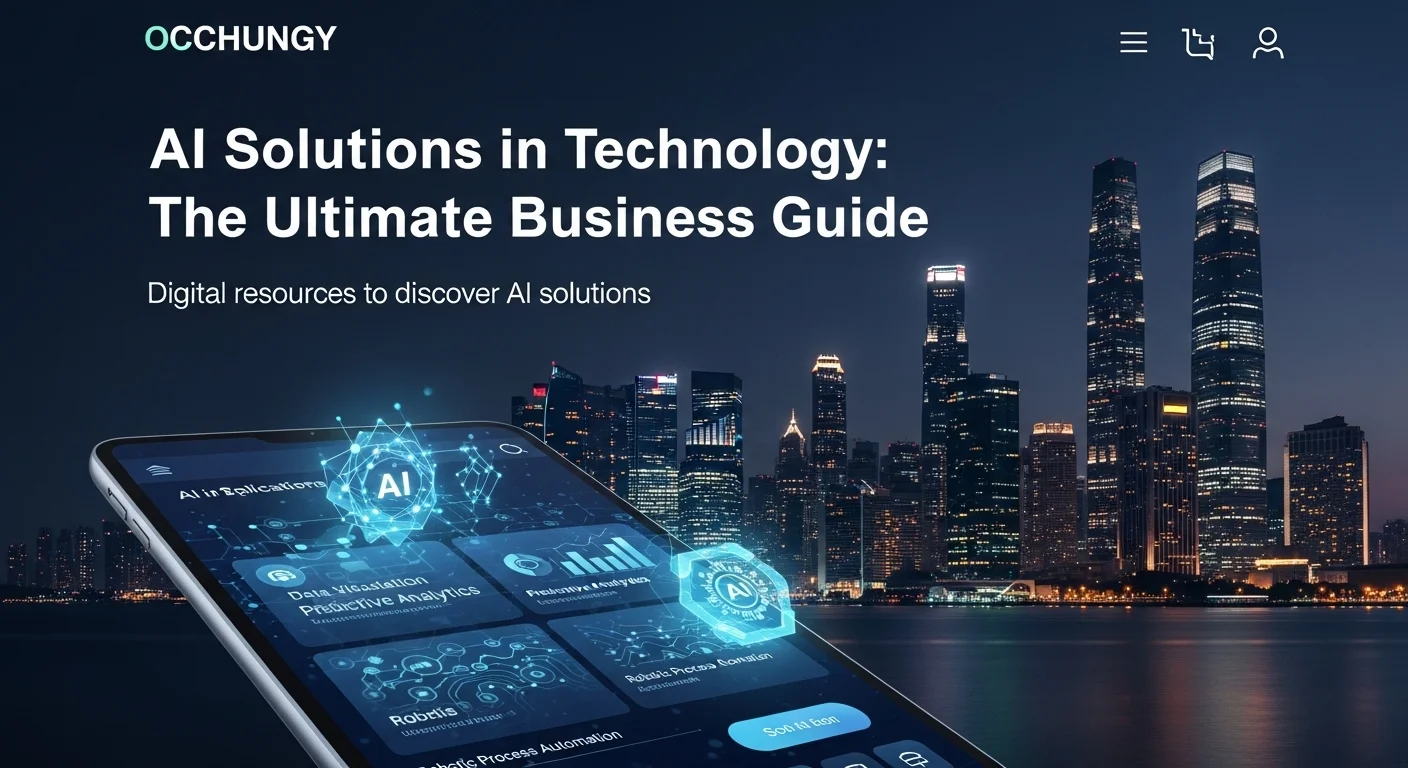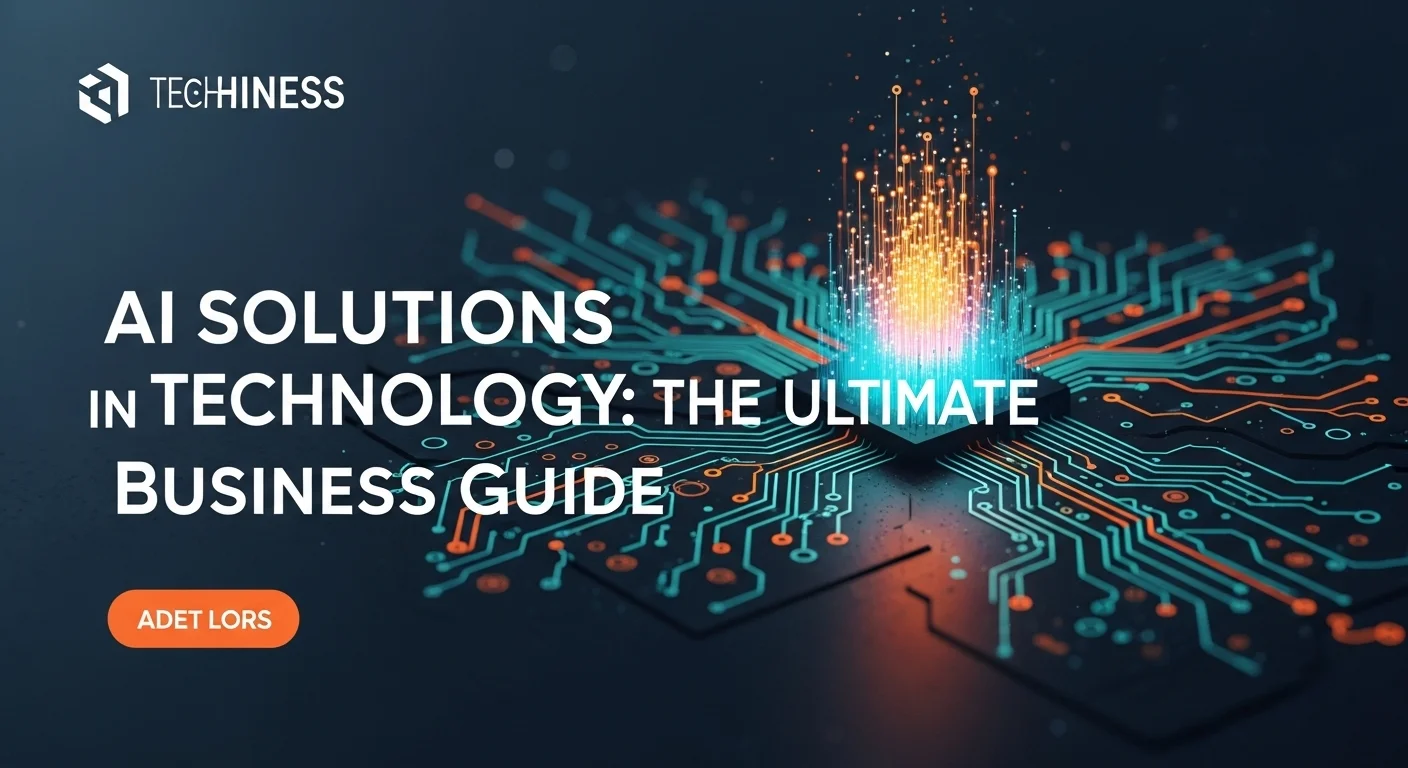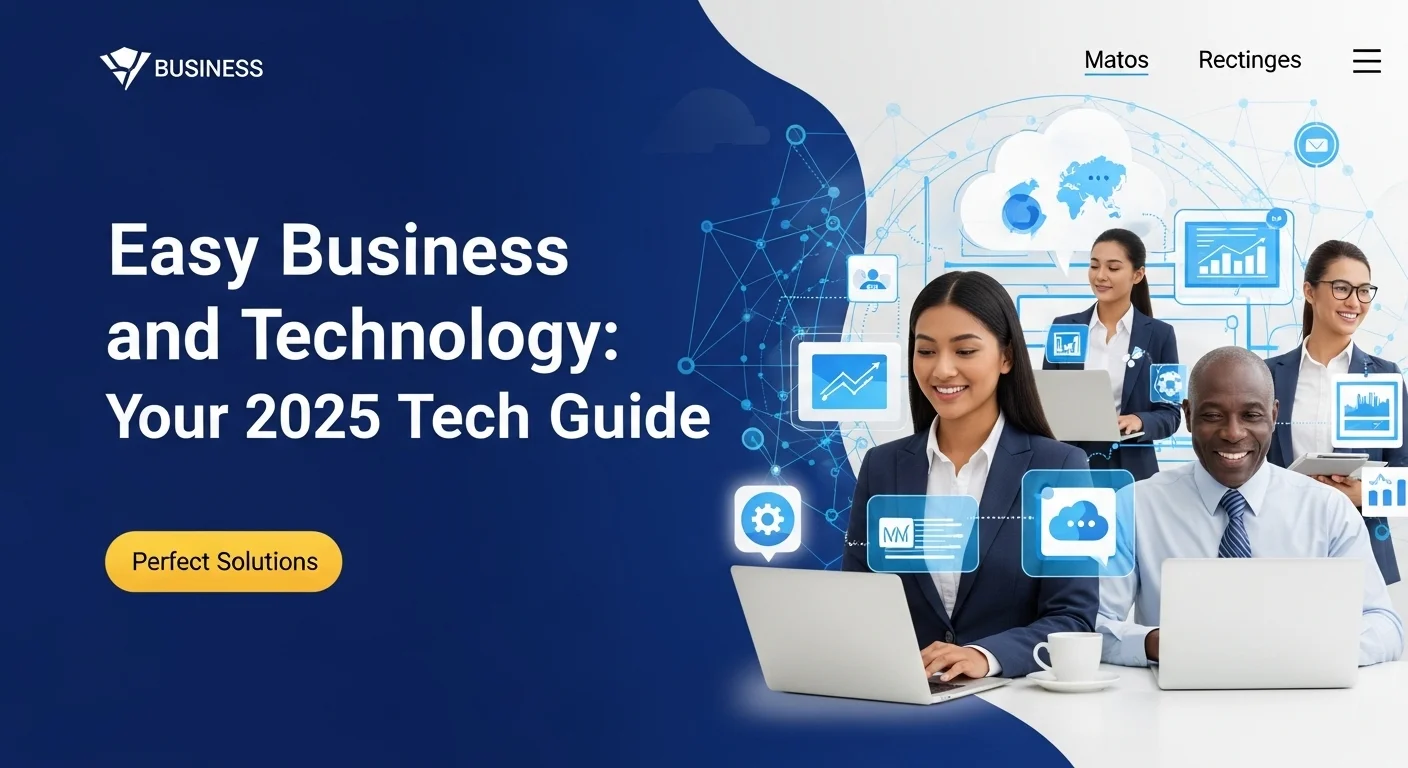AI in Business: A Practical Guide to Real-World Solutions

Executive Summary
Over my 15 years in tech strategy, I've seen countless buzzwords come and go. But Artificial Intelligence is different. It's not just a trend; it's a fundamental shift in how business gets done. This guide is my way of cutting through the noise. I want to give you a real, practical overview of how AI solutions are changing the game for companies just like yours. We'll start with the basics – what these tools actually are – and move all the way to advanced strategies for making your business smarter, faster, and more innovative. I'll share what I've learned about choosing the right tools, whether you're a complete beginner or looking to scale up. Think of this as your roadmap to understanding and using AI to not just compete, but to truly lead in your industry.
Table of Contents
What Are AI Solutions and Why Do They Matter in Technology?
In my conversations with business leaders, the term 'AI Solution' often sounds more intimidating than it is. So, let's break it down. At its heart, an AI solution is simply a smart tool designed to solve a problem or handle a task. These tools are powered by technology that allows them to learn from information, spot patterns, and make decisions, often without a person needing to guide every step. Why is this such a big deal? Because these tools are the engine of modern business, fundamentally changing how we all work. They're helping us sift through mountains of data to find golden nuggets of insight and automate the boring stuff so we can focus on what matters. Honestly, in today's market, understanding and using AI isn't just for the tech giants anymore; it's becoming essential for anyone who wants to stay competitive.
The real power of AI in technology comes from its incredible speed and scale. It can analyze information in ways no human team possibly could. This includes a few key areas you'll hear about. There's Machine Learning (ML), which is like teaching a computer by showing it examples instead of writing explicit instructions. Then you have Natural Language Processing (NLP), which helps machines understand the way we talk and write. And there's Computer Vision, which lets them interpret images and videos. You're already using these every day. The movie recommendations on Netflix? The app that alerts your bank to a strange purchase? That's all AI working for you. When a business brings these tools into its operations, it can automate tasks and free up its people to be more creative and strategic. I've seen it firsthand—it not only boosts efficiency but creates a more exciting place to work.
Getting Started: AI Basics for Business Beginners
If you're new to this, the world of AI can feel like a whole new language. But you only need to grasp a couple of core ideas to see the potential. For anyone just starting with AI in their business, it all begins with 'data'. AI is hungry for data; it's the food that helps it learn. The quality and amount of data you have will directly impact how well your AI tool works. So, the first question I always ask clients is: what information do you have, and is it in good shape? The second key idea is the 'model'. This is just the method the AI uses to get from a question to an answere. There's no single magic model. The right one depends on what you're trying to do. For example, you might use one type to predict next quarter's sales and another to sort customer emails into urgent and non-urgent folders.
Getting these basics down is your first step. It's not about becoming a data scientist overnight. It's about thinking strategically about what AI can do for *you*. My advice for beginners is always the same: start small. Find one specific, nagging problem in your business. Maybe it's answering the same customer questions over and over, or figuring out how much inventory to order. By focusing on a single, clear goal, you can get a real win, learn a ton, and build the confidence to take on bigger AI projects. Many companies now offer 'no-code' AI platforms that let you build simple tools without being a programmer, which is a fantastic way for smaller businesses to get in the game.
The Real-World Impact: How AI is Changing Business
The ways AI can be applied in business are incredibly broad and growing every day. It's not just one department's tool; it has the power to lift the entire organization. In customer service, I've seen AI chatbots transform the user experience, providing instant answers 24/7. This doesn't just make customers happier; it dramatically cuts down on support costs. In marketing, AI is like having a superpower. It can analyze customer behavior to create personalized ads and recommendations that actually feel relevant, which in turn boosts sales. These are the kinds of direct, bottom-line impacts that get executives excited about AI.
It doesn't stop there. In operations, AI can untangle complex supply chains by predicting demand and finding the most efficient shipping routes. This means less waste and faster deliveries. In factories, AI can predict when a machine needs maintenance *before* it breaks down, saving a fortune in downtime. Banks use sophisticated AI to spot fraud in the blink of an eye, protecting themselves and their customers. Even HR departments are using AI to screen resumes more fairly and find the best candidates. The common thread here is that AI turns raw data into smart actions, leading to better and faster decisions across the board. The real challenge for modern leaders is finding the best AI solutions for each part of their business.
The Tangible Wins: Benefits of Bringing AI Onboard
Integrating AI into your business brings a host of benefits that give you a real competitive advantage. The most obvious win is a boost in efficiency. By automating repetitive tasks, AI lets your team focus on high-value work that needs a human touch—like strategy, creativity, and building relationships. I've found this doesn't just make a company more productive; it makes employees happier and more engaged. Another huge benefit is cost savings. Automation cuts down on manual labor costs, and AI's ability to optimize everything from energy use to inventory can lead to big savings. Even simple AI tools for beginners can make a noticeable dent in expenses.
Beyond that, AI leads to smarter decisions. By crunching massive amounts of data, AI can spot trends and patterns a person would never see. This gives leaders the confidence to make bold, data-backed choices. Personalization is another game-changer. AI allows you to offer tailored experiences to every single customer, building loyalty and driving sales in a way that was never possible at scale. Finally, AI is a catalyst for innovation. It helps you dream up new products, services, and even entirely new ways of doing business. When you invest in AI, you're not just improving today's operations—you're securing your company's future in a world that's only getting more digital.

Your Complete Guide to AI in Technology and Business
Bringing AI into your business can feel like a huge undertaking, but with a clear map, the journey is much easier. This guide is that map. I've designed it to help you navigate the landscape and choose the best AI solutions for you. The journey always starts by asking the right question: What problem am I trying to solve? Not every challenge needs an AI fix. The best candidates are tasks that are data-heavy, have a clear definition of success, and involve repetitive work. The first thing I recommend is an honest look at your own company's processes and data. This will help you pinpoint the areas—whether it's customer support, marketing, or operations—where AI can make the biggest difference. For example, if you're drowning in customer emails, a smart chatbot is a great place to start. If your supply chain is a mess, AI-powered forecasting might be the answer.
Once you've identified a good use case, it's time to choose your tools. The market for business AI solutions is packed with options, from massive platforms by Google, Microsoft, and Amazon to specialized tools from smaller companies. Your choice will depend on your team's tech skills, your budget, and how much you plan to grow. If you don't have a team of data scientists, 'AI-as-a-Service' (AIaaS) platforms are a fantastic starting point. They offer pre-built models and are generally easy to use, making them perfect for businesses just starting with AI. On the other hand, if you have a dedicated tech team, you might want the flexibility of frameworks like TensorFlow or PyTorch to build something completely custom. I always tell people to compare not just features and price, but also the quality of support and how easily the tool will fit with the systems you already have.
Technical Methods and Business Techniques for AI Adoption
A successful AI project is a mix of smart tech work and smart business strategy. On the technical side, there's a clear process. It begins with getting your data ready, which is honestly the most important and often the longest phase. You have to collect, clean, and organize your data so the AI model can understand it. The old saying 'garbage in, garbage out' has never been truer. After the data is prepped, the data scientists can start experimenting with different algorithms—like neural networks or decision trees—to find the best one for the job. Then they 'train' the model using the data, refining it over and over until it's as accurate as possible.
On the business side, success is all about people. I've seen too many brilliant tech projects fail because the human side was ignored. You have to manage the change. Your team might worry that AI is coming for their jobs. It's crucial to communicate a clear vision of how AI will help them, not replace them—acting as a partner that handles the grunt work. Offering training can help people adapt to new, more interesting roles working alongside AI. Another key technique is to start small. Don't try to transform the whole company at once. Launch a small pilot project to prove the concept, measure the results, and learn from your mistakes before you go big. This approach minimizes risk and builds excitement and support for what you're doing.
A Comparative Look at the Best AI Solutions on the Market
Navigating the AI marketplace can be tricky. From my experience, the 'best' AI solution isn't the fanciest—it's the one that perfectly fits your specific need. We can group the options into a few categories. First, you have the big cloud platforms: Amazon Web Services (AWS), Microsoft Azure, and Google Cloud. They offer a massive menu of AI services, from raw computing power to ready-made tools for language, vision, and analytics. Their strengths are power, reliability, and the fact that all their tools work well together. They're a great choice for almost any business, big or small.
Second, there are enterprise platforms that have woven AI directly into their products. Think of Salesforce Einstein, which adds AI-powered insights right into your CRM, or SAP Leonardo, which uses AI to make its business management systems smarter. The big advantage here is convenience; the AI is already integrated into the tools your team uses every day, which makes it much faster to get value. Finally, there's a vibrant world of specialized AI startups that are experts at solving very specific problems, like analyzing medical scans or detecting complex cyber threats. They may not be as big as the cloud giants, but they often have the most advanced and innovative technology for their niche. Choosing the right one is a balancing act between the all-in-one power of a big platform, the convenience of an embedded solution, and the specialized expertise of a niche tool.
Available Resources and Building an AI-Ready Culture
Becoming an AI-driven company is about more than just technology; it's about changing your company's mindset and committing to learning. The good news is, there are tons of resources out there to help. Online learning sites like Coursera and edX have countless courses on AI, from high-level introductions for managers to deep technical training for developers. I strongly encourage companies to invest in this kind of upskilling for their teams. It creates a baseline of knowledge across the whole organization, which is critical for success.
Building the right culture also means encouraging teamwork between your tech experts and your business experts. The best AI projects I've been a part of were the ones where data scientists, engineers, and the people who would actually use the tool worked together from day one. This ensures the final product isn't just a cool piece of tech, but something that actually solves a real-world problem. Leadership is also key. Executives need to champion the AI strategy, provide the necessary budget, and, most importantly, create a culture where it's okay to experiment and even fail. Not every AI project will be a home run, but every single one is a chance to learn. By fostering a data-driven mindset and investing in your people, you create an environment where the very best AI solutions can grow and thrive.

Tips and Strategies for Using AI to Improve Your Technology Experience
Getting the most out of AI is about more than just installing new software. It's about being strategic and constantly looking for ways to improve. The single most important strategy I can share is this: focus on using AI to *augment* your team, not replace them. I've found the most powerful AI applications are the ones that act like a 'co-pilot' for an employee. They handle the tedious data work, freeing up the person to focus on things only humans can do well, like creativity, empathy, and complex problem-solving. Imagine a customer service agent who has an AI partner instantly pulling up customer history and suggesting solutions. That agent can solve problems faster and provide a better experience. This 'human-in-the-loop' approach ensures technology serves your people, not the other way around.
Another tip that I can't stress enough is to make data ethics and governance a priority from the very beginning. AI systems learn from the data you give them, and if that data has biases, the AI will learn and even amplify them. This can lead to unfair outcomes that can seriously damage your brand and destroy customer trust. To prevent this, you need clear rules for how data is collected, used, and protected. I recommend regularly auditing your AI models to check for bias and ensure they're working fairly. And be transparent. If you're using AI in a customer-facing tool, tell people. This commitment to ethical AI isn't just about following rules; it's about building a business people can trust.
Best Practices for Implementing Business Tools and Technologies
Successfully rolling out any new technology, especially something as complex as AI, comes down to following a few best practices I've seen work time and again. First, always start with a clear business goal. Don't adopt AI just because it's trendy; adopt it to solve a specific problem. Whether your goal is 'reduce customer churn by 10%' or 'improve sales forecast accuracy by 15%,' having a measurable target gives the project focus and a way to judge its success. This focus on ROI is critical for getting everyone on board.
A second best practice is to make sure your data infrastructure is rock-solid. Before you even think about an AI model, your data house must be in order. This means having reliable processes to ensure your data is high-quality, secure, and accessible. Often, investing in a modern data platform is a necessary first step for any serious AI project. A third critical practice is to foster collaboration. AI projects should never be locked away in the IT department. They need a team of data scientists, engineers, business analysts, and subject matter experts all working together. This ensures the final tool is both technically powerful and practically useful in the real world.
Exploring Quality External Links and Tech Experiences
To keep up in the fast-moving world of AI, you have to be a lifelong learner and stay connected to the wider tech community. There are some fantastic external resources that I personally rely on for insight and practical advice. For understanding the big picture and strategic side of technology, I always recommend Gartner. They are a global research firm whose reports on AI trends, vendor comparisons, and best practices are incredibly valuable for any leader building an AI strategy. Spending some time on their website can save you from common mistakes and help you find the best solutions for your needs.
Engaging with the community through conferences and online forums is also incredibly enriching. It's where you hear from the experts, see real case studies, and connect with peers who are wrestling with the same challenges you are. Platforms like LinkedIn are full of vibrant groups focused on AI, providing a great place to ask questions and share knowledge. Following key thought leaders and innovative companies on these platforms is like having a curated stream of valuable information sent right to you. For those just starting, exploring these resources is a great way to build a foundation and make the world of AI feel much more approachable.
Future-Proofing Your Business with Advanced AI Strategies
As AI technology continues to evolve at a dizzying pace, smart businesses need to look beyond today's tools and think about how to future-proof their operations. This means keeping an eye on emerging trends like generative AI, explainable AI (XAI), and reinforcement learning. Generative AI, the technology behind tools like ChatGPT, is set to revolutionize everything from writing marketing copy to designing new products. I advise clients to start experimenting with these tools now to understand their potential and find ways to get a head start on the competition.
Explainable AI (XAI) is another area I believe is critically important. As AI models get more powerful, they can also become 'black boxes,' making it hard to understand how they reached a decision. XAI is about making these models more transparent. This is absolutely essential in fields like finance and healthcare, where you have to be able to explain your decisions. Building XAI principles into your work from the start is a key strategy for building trust and staying compliant. By looking ahead and adopting these advanced strategies, you aren't just using today's AI; you're setting your business up to lead and thrive in the age of artificial intelligence for years to come.
Expert Reviews & Testimonials
Sarah Johnson, Business Owner ⭐⭐⭐⭐
As a small business owner, I found this guide on AI solutions a great starting point. It really helped demystify the topic. I do wish there were a few more case studies for retail, but it definitely cleared up a lot of my initial questions.
Mike Chen, IT Consultant ⭐⭐⭐⭐⭐
Solid overview of the current AI landscape for business. As an IT consultant, I appreciated the breakdown of different platforms and the emphasis on starting small. It's a great resource to share with clients who are just dipping their toes into AI.
Emma Davis, Tech Ethicist ⭐⭐⭐⭐⭐
Absolutely fantastic article! I'm specializing in AI ethics, and the emphasis on a human-centric approach, transparency, and data governance was spot-on. It's comprehensive, clear, and incredibly valuable. Highly recommend!



